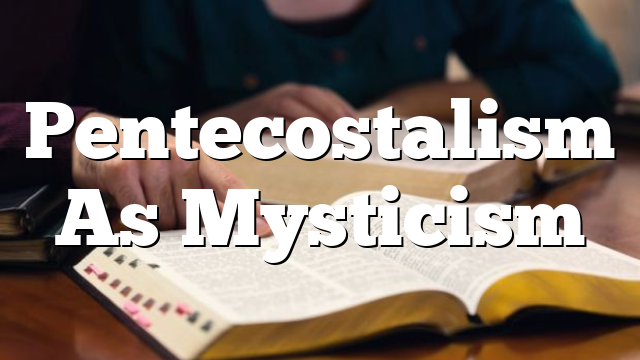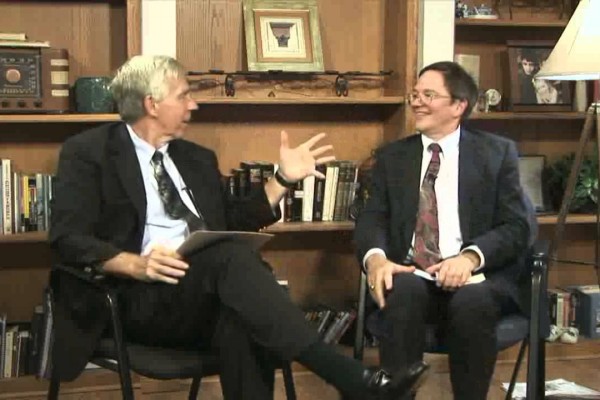Click to join the conversation with over 500,000 Pentecostal believers and scholars
Click to get our FREE MOBILE APP and stay connected
| PentecostalTheology.com



Pneuma 33 (2011) 1-4
Pentecostalism, Mysticism, and
Renewal Methodologies
Dale M. Coulter
In their own way, the articles in this issue tackle the thorny subject of renewal methodologies with respect to pentecostalism as a whole and historical docu- ments in particular — even inspired ones from the ancient Near East to the first century. At one level Mittelstadt’s review essay of Pervo’s works vis-à-vis Luke-Acts scholarship highlights many of the critical hermeneutical issues that pentecostal scholarship has been explicitly engaging in the last thirty years. But at another level, more is at stake with regard to how renewal methods are or are not informed by pentecostal and charismatic experiences. Some are more open to such correlations than others. For example, by utilizing Gustavo Gutiérrez’s mysticism as a bridge between pentecostalism and liberation theol- ogy, Davis instinctively moves toward common terrain even as he cautiously asserts that mysticism and pentecostalism are only analogues. But others are less optimistic about the fruitfulness of such analogies. One finds such a reti- cence in Charette’s and Shelton’s concerns about Levison’s flirtation with Hel- lenistic notions of ecstasy in Luke-Acts. Tese reservations about mysticism and ecstasy surface as flash points in the contested domain of how to negotiate the layers of meaning within and between texts and culturally diverse histori- cal contexts. Te remaining articles only underscore the continued preoccupa- tion with method that is the heritage of modernity, and even postmodernity. Levison’s work, and the responses to it, highlights two theological concerns that should inform ongoing discussions about renewal methodologies because of their centrality to pentecostal spirituality. Te first is the complex nature of the relationship between the human spirit and the Holy Spirit while the sec- ond concerns the “mechanics” of such a relationship. Both concerns point toward what Frank Macchia previously editorialized upon in these pages as finitum capax infiniti (the capacity of the finite for the infinite). As a descriptor of a particular kind of divine/human encounter, ecstasy both reveals this capacity and the thorns that emerge in teasing out its dynamics. It may be that
© Koninklijke Brill NV, Leiden, 2011 DOI: 10.1163/157007411X554659
1
2
D. M. Coulter / Pneuma 33 (2011) 1-4
a more thorough analysis of ecstasy will affirm the deep mystical vein that flows through pentecostalism in a manner that helps illuminate these two theological concerns and their implications for renewal methodologies.
Drawing upon Wesley, and indeed the entire revivalist tradition, early pen- tecostals understood the precise locus of encounter to be human affectivity. Affectivity is a shorthand description of dispositional traits that give rise to movements of emotion and desire in the soul. One may, as Augustine did, speak of the disposition to long or yearn for the other as disordered or ordered affectivity. Te former he saw as concupiscentia or cupiditas and the latter as caritas. Te difference between these two was not the interior movement of longing for the other, but its particular direction. Augustine knew that it was through their affective movements that humans placed value upon other per- sons or objects. Concupiscence was simply affective longing for temporal realities that led humans to value them above eternal realities; charity properly ordered the soul’s interior yearnings by directing them toward God and then creation. Whether they realized it or not, early pentecostals inherited this Augustinian tradition of affectivity as the central element in their theology of encounter.
Te emphasis on affectivity runs as an undercurrent in the continuous return to love as the central characteristic of Spirit baptism. Spirit baptism was nothing less than the ecstatic embrace of the bride by the Bridegroom. Indeed, Spirit baptism made one a member of the bride, which is why tongues became so important as a sign of such an ecstatic encounter. When Parham’s tongues- as-foreign-language thesis failed, early pentecostals like William Seymour and G. B. Cashwell shifted to the thesis of unknown tongues as evidence of bridal union. While accepting the holiness theology that encounters with God made one a member of the bride, pentecostals added that the clearest testimony to these encounters was speaking the eschatological language of the Bridegroom. Consequently, Spirit baptism concerned an ecstatic encounter between bride and Bridegroom in which the individual was “caught up” in affective union with Jesus, tongues being the clearest sign of this union.
From this perspective, the capax dei occurs within the psychological dynam- ics of affective response that in turn releases human rationality to perceive more clearly the things of God. One may think of spiritual intoxication in which to be transfixed on heavenly realities by the wonder and beauty they evoke is nothing less than to be caught up affectively in the divine presence. It is more akin to the expression “drunk with rage” in which the individual is taken over by emotion and desire than drunk with wine, and yet the analogical correspondence remains. At the same time, such intoxication serves to break
2
D. M. Coulter / Pneuma 33 (2011) 1-4
3
the affective connection to the “things of this world” such that it has a sobering effect. To be drunk with the Spirit is to be sober with respect to the world. Augustine the Christian knew that Augustine the Manichean had become so drunk on material realities, so filled with their presence, that he could not see beyond the material world, even when considering the problem of evil. To become a Christian required that the affective bond of emotion and desire to the material world be broken, and this could only happen in the ecstatic embrace of the Beloved through the charity that is the Spirit. Te locus of encounter between the Holy Spirit and the human spirit — the capax dei — is the affective dimension of the human person, and it points toward the rela- tional center.
By focusing on ecstasy and encounter in early pentecostalism, one can gain a methodological sensitivity to the structural similarities with the dynamics at work in early Christianity. Tis is especially the case over the tension early Christians felt between soberness with respect to the world and the intoxica- tion of the Spirit. For example, while Tertullian distances himself from Ath- ens, he seems to move toward Delphi. One of his works (De ecstasi) — no longer extant — was a defense of the New Prophecy’s understanding of ecstasy as a trance-like possession of the individual. Speaking for God, Montanus himself had prophesied that “a human being is like a lyre and I hover like a plectrum. Te human being sleeps but I remain awake.” When he embraced this “renewal” movement within second-century Christianity, Tertullian found himself gravitating toward Delphi and Jerusalem at the same time. He did this by distinguishing the “mechanics” of inspiration — its ecstatic nature — from the narrative core of the Christian message communicated in the regula fidei. What makes the New Prophecy intriguing is its insistence on rigorous asceti- cism (holiness), prophetic ecstasy, and the full participation of men and women. One finds similar emphases within early pentecostal writers. Tis same structural similarity might be applied to Luke-Acts as a method- ological principle. From this perspective, Levison’s thesis about Hellenistic notions of ecstasy providing a subtext to Luke’s description of Pentecost should not seem so far fetched. It was not simply that Peter’s speech clarified the nature of the event; rather, the intoxicating experience of fiery tongues gave rise to the clarity of Peter’s speech. To be in the intoxicating presence of the Spirit, to be erotically transformed through the Bridegroom’s linguistic touch — these are the signs of ecstasy and they free the individual from affec- tive longing for the world and open up a new visionary world of the divine. Is this not the pneumatological imagination at work, the expansion of human horizons in the affective embrace that is Spirit baptism? If Levison is correct
3
4
D. M. Coulter / Pneuma 33 (2011) 1-4
about the Hellenistic parallels that form literary subtexts, he is also correct to suggest that they merely fill out the richness of an eschatological in-breaking Luke is desperately trying to describe.
Te debate about the specifics of renewal methodologies should continue. I have tried to suggest how beginning with early pentecostalism in light of Levison’s two theological concerns about the relationship between the Holy Spirit and the human spirit and the mechanics of such a relationship can yield some methodological potential, even for the study of first-century texts like Luke-Acts. What the interpreter needs are the new imaginative horizons that the Spirit can and does open through the intoxicating experience of ecstasy. Early pentecostals had their imaginative horizons opened, and it led them to make radical assertions, such as that the color line had been washed away just three short years after W. E. B. Dubois had claimed that problem of the color line would be the problem of the twentieth century. Such a political statement emerged from a political vision birthed in the soberness of ecstasy. One won- ders whether the clarity of the political vision Peter offered on the Day of Pentecost was not borne from the same fires. If nothing else, pentecostal schol- ars need to be methodologically open to the possibilities.
4




Most Talked About Today